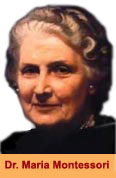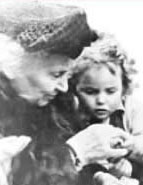 Dr. Maria Montessori & How the Montessori Method Began
Dr. Maria Montessori & How the Montessori Method Began
Maria Montessori was born in Ancona, Italy in 1870. When she was twelve, the family moved to Rome. At the age of thirteen, against the wishes of her father but with the support of her mother, she began to attend a boys’ technical school. After seven years of engineering, she applied to medical school at the University of Rome.
In 1896, Dr. Montessori became the first woman to graduate from the University of Rome Medical School. She then joined the staff of the University in the Psychiatric Clinic, where she worked with children in the insane asylums of Rome. Maria Montessori became convinced that these children could profit from special education. She started by using ideas and didactic materials of earlier educators, such as Itard and Seguin. Then, she elaborated on these materials and developed new ones based on her observations, notes and intensive work. To her amazement, these children started learning many things that had seemed impossible.
Dr. Montessori returned to the University of Rome to study philosophy, psychology and anthropology. She also served on the staff of the Women’s Training College in Rome. In 1904, she was made a professor of anthropology at the University of Rome. Her desire to help children was so strong that in 1906, she decided to dedicate herself totally to the study of education and human development.
In 1907, Dr. Montessori was asked to take over a daycare centre in San Lorenzo, one of the poorest quarters of Rome. It was there that she founded the first Casa dei Bambini (Children’s House), which consisted of approximately sixty underprivileged children between the ages of three and six years. In less than a year, these children had become self-assured, self-motivated, responsible individuals. They had also begun to read and write spontaneously, which caught the public eye. These children became known throughout the world as Dr. Montessori’s “miracle children”. The news of this unprecedented success soon spread around the world. Maria Montessori began a life of world travel, establishing schools and teacher training centers, lecturing and writing.
In Rome, Dr. Montessori developed a program for the Elementary years, for children from 6 to 12 years-old. Working within a mixed-age group, using specifically designed materials, and being allowed to explore and research, led the children to achieve a much higher level than was previously thought possible for children of this age.
In 1922, Dr. Montessori was appointed Government Inspector of Schools in Italy. In 1929, Dr. Montessori founded The Association Montessori Internationale (AMI) to ensure that the integrity of her work would be maintained and that it would be perpetuated after her death. In 1931, Maria Montessori was forced into exile from Italy because of her antifascist views. She lived in Spain, India, and in the Netherlands, which is now the headquarters of the Association Montessori Internationale (AMI).
In the 1940’s, inspired by the amazing potential of children realized in the early years, Dr. Montessori stated that age three was too late to begin to support the work and development of the child. In 1947, she created an Infancy program.
Dr. Montessori was nominated for the Nobel Peace Prize three times – in 1949, 1950, and 1951. She died in Noordwijk aan Zee, Holland, in 1952, but not without leaving a legacy we can embrace to this day. Since Maria Montessori’s death, an interest in her Method of Education has continued to spread throughout the world. Her message was always to turn one’s attention to the child, to “follow the child”. It is because of this basic tenet, and the guidelines left by her, that Dr. Montessori’s ideas will always be on the leading-edge in Education.
The Montessori Method
“I have studied the child. I have taken what the child has given me and expressed it and that is what is called the Montessori Method.”- Dr. Montessori
Montessori is both a methodology and an educational approach, based on Dr. Maria Montessori’s scientific observations of children’s needs and natural learning tendencies. Her studies of children from all racial, cultural and socio-economic backgrounds allowed her to develop universal educational principles. These, together with a vast range of self-correcting materials and a prepared environment for multi-age group, came to be known as the Montessori Method of Education.
The Montessori Method is more than an academic program. It is a whole approach to life, which is one of respect, compassion, and guidance in all areas of learning. Maria Montessori believed that Education should not just be academic but that it should also be an aid to life. Her observations led her to understand that children have special sensitivities at different stages of their development. By preparing learning environments responsive to those characteristics, children not only learn academic skills with ease and enthusiasm but they also develop creativity, self-esteem, self-discipline, problem solving, critical thinking, care, and respect for others and for the world – all which lead to becoming fulfilled individuals and contributing positively to the environment and society. This is the essence of the “Montessori Method”.
Characteristics of Montessori
“Our aim is not merely to make the child understand, and still less to force him to memorize, but to touch his imagination as to enthuse him to his inmost core”– Dr. Montessori
- The primary goal of Montessori is to help each child reach full potential in all areas of life.
- It offers a broad vision of Education as an aid to life.
- It provides each child with an individual learning program. Children learn at their own pace, according to their personal abilities, capabilities, interests and needs.
- The child’s natural joy of learning is nurtured and stimulated.
- Children are encouraged to explore, experiment and investigate.
- Children enjoy independence, freedom of movement and choice (freedom within appropriate limits).
- Children are respected as different from adults, and as individuals who are different from one another.
- Children develop themselves through spontaneous and purposeful activities.
- Children flourish in an atmosphere of acceptance, trust and respect.
- Children’s creativity is fostered in all areas of the curriculum.
- Children are seen as competent beings capable of self-directed learning.
- The Montessori Method uses specifically designed, enticing and self-correcting materials which provide each child with a foundation for academics and every field of study.
- Emphasis is given on concrete rather than on abstract learning – Children experience concepts in concrete “hands-on” ways using sensory-based materials.
- Provides a learning environment which has been carefully prepared to be geared to the children’s size, interests, and to allow a maximum amount of independence.
- The classroom environment offers the essential elements for optimal social and academic development. The key components are: the children, a trained teacher and assistant(s), the physical surroundings, and Montessori educational activities.
- A learning environment which embodies: beauty, order, reality, simplicity and accessibility.
- Mixed-age group within classrooms to encourage all children to develop their personalities socially and intellectually.
- Focuses on the importance of observation of the child interacting with their learning environment as the basis for ongoing curriculum development.
- Teachers play an unobtrusive role. They act as guides and observers.
Suggested Reading
Please find below a list of suggested books for additional information about Dr. Montessori, the Montessori Method, and early childhood development:
Book written by Dr. Maria Montessori
- The Discovery of the Child
- The Montessori Method
- The Advanced Montessori Method, vols. I and II
- The Secret of Childhood
- The Child in the Family
- Education for a New World
- To Educate the Human Potential
- What you Should know About Your Child
- The Absorbent Mind
- The Formation of Man
- Education and Peace
- From Childhood to Adolescence
- Dr. Montessori’s Own Handbook
Book written about Montessori:
- Education for Human Development by Mario Montessori Jr.
- Maria Montessori by Rita Kramer
- Montessori: A Modern Approach by Paula Polk Lillard
- Montessori Today by Paula Polk Lillard
- Montessori in the Classroom by Paula Polk Lillard
- Montessori from the Start by Paula Polk Lillard
- Maria Montessori: Her Life and Work by E.M. Standing
- Montessori: the Science Behind the Genius by Angeline Stoll Lillard
- Montessori and the Special Child by Reginal Calvert Orem
- Our Peaceful Classroom by Aline D. Wolf
- A Parent’s Guide to the Montessori Classroom by Aline D. Wolf
Books on early childhood development:
- Understanding the Human Being by Silvana Montanaro
- Touching by Ashley Montagu
- The Secret Life of the Unborn Child by Thomas Verny
- Whole Child, Whole Parent by Polly Berends Berrein